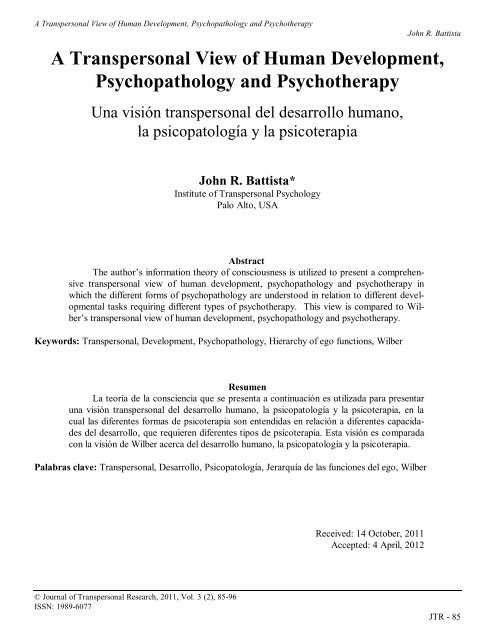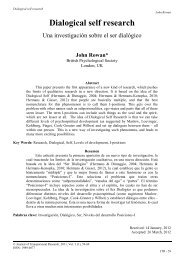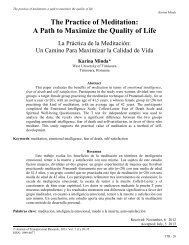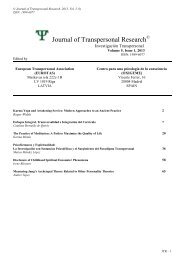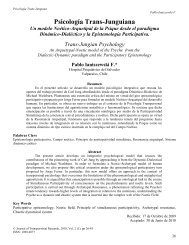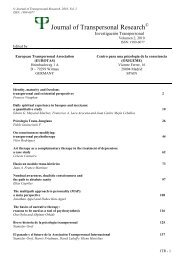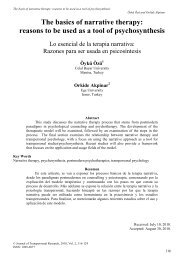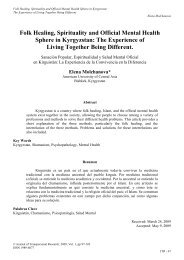John R. Battista - Journal of Transpersonal Research
John R. Battista - Journal of Transpersonal Research
John R. Battista - Journal of Transpersonal Research
You also want an ePaper? Increase the reach of your titles
YUMPU automatically turns print PDFs into web optimized ePapers that Google loves.
A <strong>Transpersonal</strong> View <strong>of</strong> Human Development, Psychopathology and Psychotherapy<strong>John</strong> R. <strong>Battista</strong>[The <strong>Journal</strong> <strong>of</strong> <strong>Transpersonal</strong> <strong>Research</strong> has decided to publish this article as it has been positively peerreviewed and because <strong>of</strong> its theoretical interest and its clarifying explanations. However, it is acknowledgedand it is stressed that the references are very old and have not been updated].Introduction<strong>Transpersonal</strong> psychiatry and psychology are <strong>of</strong>ten conceptualized as branches <strong>of</strong> psychiatry and psychologyconcerned with transpersonal states <strong>of</strong> consciousness. However, transpersonal psychiatry and psychologyare not limited to the study <strong>of</strong> transpersonal states. They are encompassing approaches to psychiatryand psychology which are informed by transpersonal states and integrate them into a general psychologicaltheory <strong>of</strong> normal, healthy and disturbed human development and experience.The encompassing nature <strong>of</strong> a transpersonal perspective is evident in Wilber’s spectrum psychology,which provides an excellent example <strong>of</strong> a transpersonal approach to human development, psychopathologyand psychotherapy. In The Spectrum <strong>of</strong> Consciousness Wilber (1977) contends that consciousness is best understoodas a spectrum <strong>of</strong> types or forms <strong>of</strong> awareness. In The Atman Project, Wilber (1980) shows how theseforms <strong>of</strong> consciousness are ordered structures <strong>of</strong> human development that evolve through prepersonal, personaland transpersonal stages. In Transformations <strong>of</strong> Consciousness, Wilber (1986) he argues that the disruption<strong>of</strong> these developmental stages result in identifiable psychopathologies. Finally, Wilber (1986) contendsthat particular types <strong>of</strong> psychotherapy are particularly appropriate for particular developmental psychopathologies.This paper provides another example <strong>of</strong> a transpersonal approach to psychology and psychiatry by extendingthe author’s information theory <strong>of</strong> consciousness (<strong>Battista</strong>, 1978) into a somewhat different model <strong>of</strong>development, psychopathology and psychotherapy, which is compared to Wilber’s.The Development <strong>of</strong> Human ConsciousnessThe first step in developing a transpersonal theory <strong>of</strong> psychopathology and psychotherapy is to extenda general theory <strong>of</strong> consciousness into a theory <strong>of</strong> the development <strong>of</strong> consciousness. A previously publishedtheory (<strong>Battista</strong>, 1978) <strong>of</strong> human consciousness involves six forms: perception, emotion, subjective awareness,ego awareness, self-awareness, and transpersonal consciousness. This section attempts to show how theseforms <strong>of</strong> consciousness are manifestations <strong>of</strong> increasingly encompassing structures that can be understood interms <strong>of</strong> the development <strong>of</strong> the self. Six different self structures are identified, and transitions from one to thenext are discussed in terms <strong>of</strong> six orders <strong>of</strong> ego functions which resolve uncertainty associated with six developmentaltasks.Table 1 shows the relationship among the six self-structures, six levels <strong>of</strong> consciousness, six developmentaltasks, and six orders <strong>of</strong> ego functions (information processing functions) in comparison to Wilber’sstages <strong>of</strong> development.© <strong>Journal</strong> <strong>of</strong> <strong>Transpersonal</strong> <strong>Research</strong>, 2011, Vol. 3 (2), 85-96ISSN: 1989-6077JTR - 86
A <strong>Transpersonal</strong> View <strong>of</strong> Human Development, Psychopathology and Psychotherapy<strong>John</strong> R. <strong>Battista</strong>Table 1Self-Structures and the Development <strong>of</strong> ConsciousnessDevelopmentalTaskseparation <strong>of</strong>consciousnessfrom unconsciousnessseparation <strong>of</strong>external andinternalseparation <strong>of</strong>person fromothersseparation <strong>of</strong>identity fromsubjective sense<strong>of</strong> selfseparation <strong>of</strong>authentic selffrom identifiedselfseparation <strong>of</strong>transpersonalself from authenticselfOperation(InformationProcessingFunction)nervous sytemdevelopmentResulting Level<strong>of</strong> ConsciousnessResulting SelfstructureWilber EquivalentStructure<strong>of</strong> Consciousnessperceptual perceptual sensori-physicalmotor emotional emotional phantasmicemotionalinterpersonal subjective(representational)subjective rep-mindinternalization ego awareness ego-identified rule-role minddiscrimination,acceptance andintegrationself-awareness existential vision-logicdisidentification transpersonal transpersonal(realized)psychicsubtlecausalThe first developmental step takes place in utero with the development <strong>of</strong> the nervous system. Theperipheral nervous system has the capacity to transduce the physical environment into patterns <strong>of</strong> nervous systemimpulses transmitted to the central nervous system. The decoding <strong>of</strong> this sensory information by the centralnervous system generates perceptions <strong>of</strong> the physical environment. Sensory information is the object <strong>of</strong>consciousness and perception is the subject <strong>of</strong> consciousness. This is the perceptual order <strong>of</strong> consciousnesswhich comprises the first self-structure, the “perceptual-self.”The newborn infant is unable to regulate her own physiology. The resulting perceptual uncertainty isassociated with distress (negative affect). The infant expresses this distress through instincts such as crying,rooting, and reaching out (Bowlby, 1982). These lead caretakers to respond to the infant’s needs, ideally resultingin emotional satisfaction and secure attachment (Karen, 1994). In addition, the infant perceives changesin the external environment (Stern, 1985) and is instinctually programmed to operate on the resulting perceptualuncertainty through motor actions (Karen, 1994). These motor operations allow the infant to organizepercepts into physical objects. By between two and seven months, the infant can make a distinction betweenher physical body in an external world <strong>of</strong> objects and the emotions <strong>of</strong> an internal world that exist in relation toattachment figures (Stern, 1985). With this distinction <strong>of</strong> internal and external, the infant has achieved a se-© <strong>Journal</strong> <strong>of</strong> <strong>Transpersonal</strong> <strong>Research</strong>, 2011, Vol. 3 (2), 85-96ISSN: 1989-6077JTR - 87
A <strong>Transpersonal</strong> View <strong>of</strong> Human Development, Psychopathology and Psychotherapy<strong>John</strong> R. <strong>Battista</strong>about it. Possibility and uncertainty about identity are resolved through discriminating self-awareness whichallows the construction <strong>of</strong> an existential self. With the acceptance <strong>of</strong> one’s self and affirmation <strong>of</strong> one’s valuesand beliefs, an authentic self can be constructed. With this construction a new level <strong>of</strong> consciousness, selfawareness,and a new self-structure, the existential-self, have been attained. Identity is now the object <strong>of</strong> consciousnesswhile the sense <strong>of</strong> being one’s own true self, is what one is subject to.The sixth stage <strong>of</strong> development involves operating on the existential-self and the discriminating, constructivenature <strong>of</strong> self-awareness characteristic <strong>of</strong> the preceding stage. For most people this is initiated bycalling into question the purpose, meaning, or significance <strong>of</strong> the life, person, and work one has been constructing.Sometimes it is initiated by the realization that one is embodied and will die, a realization facilitatedby the development <strong>of</strong> a physical illness or encounter with death. Sometimes it is initiated by the spontaneousexperience <strong>of</strong> transpersonal states or a “higher power”. In any case, the constructive nature <strong>of</strong> discriminatingself-awareness must be transcended. Many techniques for this purpose have been delineated in the contemplativetraditions. In some techniques the person deconstructs self-awareness by witnessing it. In other techniques,self-awareness is transcended by concentrating on an object, sound, or image until all distinctions fallaway. Techniques, such as koan, emphasize contemplation on questions and concepts that require the personto pass beyond constructive, rational consciousness to enlightenment. Similarly, devotion, prayer and servicecan lead beyond self-awareness to the transcendence <strong>of</strong> subject-object distinction. In all these approaches,disidentification with the existential-self who thinks, acts, discriminates, labels, evaluates, and constructs takesplace. Through disidentification a new order <strong>of</strong> consciousness, transpersonal, and a new self-structure, therealized-self, comes into being. Here there is no subject or object <strong>of</strong> consciousness, only pure awareness.This model <strong>of</strong> development is summarized in Table 2.Table 2The Development <strong>of</strong> the SelfDevelopment <strong>of</strong>the SelfDevelopmentalTaskPeriod in whichtakes placeOperations utilizedObjects <strong>of</strong> consciousexperienceFirst Task SecondTaskThird Task FourthTaskFifth Taskdevelopment separation development developmentdevelop-<strong>of</strong> perception <strong>of</strong> inner <strong>of</strong> sense <strong>of</strong><strong>of</strong> ment <strong>of</strong> au-and outer selfidentity thentic selfin utereo first year second Year 2-12 years adolescenceand adulthoodCNSdevelopmentsensory inputmotor operationsonperceptionsperceptualworldemotionalattachments,emotionspersonalself,impulsesinterpersonalcommunicationinternalizationdiscrimination,acceptanceand integrationidentity, beliefs,roles,Sixth Taskdevelopment<strong>of</strong> arealized selfmaturitydisidentificationpersonality,constructiveconsciousnessContext <strong>of</strong> conscious-nesswombphysicalworld andcaretakersemotionalattachmentsfamily,school andcommunityrelationswith societyand significantothersuniverse andself© <strong>Journal</strong> <strong>of</strong> <strong>Transpersonal</strong> <strong>Research</strong>, 2011, Vol. 3 (2), 85-96ISSN: 1989-6077JTR - 89
A <strong>Transpersonal</strong> View <strong>of</strong> Human Development, Psychopathology and Psychotherapy<strong>John</strong> R. <strong>Battista</strong>problem with this level <strong>of</strong> the development <strong>of</strong> the self. This is the “very severe or psychotic level” <strong>of</strong> psychopathology.The third developmental task involves the separation <strong>of</strong> conscious being from emotion, and subjectiveself from other, through interpersonal operations on the emotional attachments formed in the preceding developmentalstage. These interpersonal operations result in the ability to regulate emotion in relation to others.Failure to accomplish this developmental task is indicated by the failure to develop a coherent personal self,the inability to separate self and other, the inability to utilize another to regulate affect, the regulation <strong>of</strong> affectthrough pathological means (non-intrapsychic, non-interpersonal), or the continued reliance on immature attachments.The failure to develop a coherent personal self is indicated by dissociation, fragmentation, andsplitting. The inability to utilize another to regulate affects is indicated by rage attacks, grandiosity, devaluation,or schizoid withdrawal. The inability to differentiate one’s self from another is indicated by projectiveidentification and projection. The control <strong>of</strong> emotion through pathological means is indicated by substanceabuse, sexual perversions, sexual or physical abuse, rocking, head-banging, and self mutilation. The continuedexistence <strong>of</strong> immature attachments is indicated by idealization, abandonment depression and extreme dependency.All <strong>of</strong> these behaviors and ego functions are indicative <strong>of</strong> a “severe or borderline” level <strong>of</strong> psychopathology.The fourth developmental task involves the separation <strong>of</strong> identity from being through the internalization<strong>of</strong> attitudes and functions. These internalizations ideally result in the establishment <strong>of</strong> a positive, accurate,socially adaptive identity and the capacity to intrapsychically control emotions and impulses. Failure to successfullycomplete this developmental task results in a negative self image, or socially maladaptive means <strong>of</strong>relating to society. Socially maladaptive means <strong>of</strong> relating to society are manifest as a failure to modulateone’s needs or impulses in relation to others, a tendency to blame others for conflicts, and a tendency to denyone’s own role in generating conflict. Ego functions and behaviors which indicate this failure <strong>of</strong> adaptationare impulsivity, acting out, denial, lying, cheating, lack <strong>of</strong> concern for others, and displacement <strong>of</strong> responsibility.These behaviors and ego functions are indicative <strong>of</strong> a “moderate or characterological” level <strong>of</strong> psychopathology.The fifth task in the development <strong>of</strong> the self involves the differentiation <strong>of</strong> identity from self, and thereconciliation <strong>of</strong> ideal self images, real self images, and internalized beliefs into an authentic, existential self. Afailure in this process is indicated by maintenance <strong>of</strong> an impersonal, non-intimate social self, or an inauthenticself-structure characterized by inaccurate self images or confusion about how to be in the world. An impersonalsocial self is indicated by the use <strong>of</strong> intellectualization, emotional distance, denial, or disavowal as ameans <strong>of</strong> coping. Confusion is indicated by use <strong>of</strong> ambivalence, passive-aggressive behavior, reaction formationand doing-undoing as means <strong>of</strong> coping. These behaviors and ego functions refer to a “mild or neurotic”level <strong>of</strong> psychopathology. Successful resolution <strong>of</strong> this developmental stage is manifest by acceptance,humor, sublimation, and integration--ego functions characteristic <strong>of</strong> healthy adult functioning.The sixth task in the development <strong>of</strong> the self involves stilling the constructive nature <strong>of</strong> self-awarenessand allowing the emergence <strong>of</strong> a realized self. Such a realized self is characterized by transpersonal states <strong>of</strong>consciousness, resolution <strong>of</strong> polarity, compassion, and altruism. Difficulties with this transition may resultfrom the misuse <strong>of</strong> spiritual concepts to serve the defensive functions <strong>of</strong> earlier developmental stages or mayemerge from the establishment <strong>of</strong> a new “spiritual” identity as a means <strong>of</strong> avoiding the difficulty <strong>of</strong> renouncingone’s attachment to an ego identity. The misuse <strong>of</strong> spiritual concepts to serve defensive functions results inpseudospiritual or inauthentic spirituality characterized by inaccurate self-attributions <strong>of</strong> spiritual developmentto serve narcissistic and defensive functions (<strong>Battista</strong>, 1996a). Alternately, identification with the spiritual anddifficulty disidentifying with one’s identity results in inflation <strong>of</strong> the ego rather than its transcendence. Thedifficulties and problems <strong>of</strong> earlier ego identity formation become amplified in inflation. Inflation can appearpsychotic-like and needs to be distinguished from psychotic states (Luk<strong>of</strong>f and Turner, 1996). Inflation can© <strong>Journal</strong> <strong>of</strong> <strong>Transpersonal</strong> <strong>Research</strong>, 2011, Vol. 3 (2), 85-96ISSN: 1989-6077JTR - 91
A <strong>Transpersonal</strong> View <strong>of</strong> Human Development, Psychopathology and Psychotherapy<strong>John</strong> R. <strong>Battista</strong>serve the process <strong>of</strong> spiritual development by presenting developmental problems to awareness to be workedthrough (Luk<strong>of</strong>f, 1996; Scotton and Hiatt, 1996; Gr<strong>of</strong> and Gr<strong>of</strong>, 1989).This developmental model <strong>of</strong> psychopathology defines a continuum <strong>of</strong> health and illness beginning withpsychosis and progressing through borderline and characterological levels into neurotic, healthy and transpersonalpsychological structures (<strong>Battista</strong>, 1981). This continuum defines a hierarchy <strong>of</strong> ego functions which isconsistent with empirical findings (<strong>Battista</strong>, 1982). A factor analysis <strong>of</strong> global assessment scale ratings, as ameasure <strong>of</strong> psychological health/disturbance, utilizing the levels <strong>of</strong> psychopathology defined above through anego function inventory, was able to account for the variance in the global assessment scale ratings <strong>of</strong> a clinicalpopulation at the .001 level, providing good empirical support for this developmental continuum <strong>of</strong> ego functions(<strong>Battista</strong>, 1982 and <strong>Battista</strong>, unpublished).Table 3 presents an overview <strong>of</strong> the psychopathology <strong>of</strong> the self.Table 3The Psychopathology <strong>of</strong> the SelfDevelopmentalTaskseparation <strong>of</strong> innerand outerformation <strong>of</strong> personand separation fromotherformation <strong>of</strong> identityformation <strong>of</strong> authenticselfLevel <strong>of</strong> psychopathologypsychoticvery severeborderlineseverecharacterologicalmoderateneuroticmildEgo-functions thatmark psychopathologyhallucinationsdelusionsideas <strong>of</strong> referenceprojectiondissociation, fragmentation,splitting,grandiosity, projectiveidentification,emotionaldyscontrol, idealization,abandonmentdepressionimpulsivity, actingout, denial, cheating,lying, displacementambivalence, passive-aggression,reactionformation,doing-undoing, intellectualization,disavowal,alo<strong>of</strong>nessrealize self spiritual problems psuedospiritualityego-inflationEgo-functions thatmark successintact reality testingcapacity to regulateemotion internallyand or interpersonallypositive self conceptsocial adaptationsublimation, humor,acceptance, humor,integrationselflessness, humility,compassion, loveThe Psychotherapy <strong>of</strong> the Self© <strong>Journal</strong> <strong>of</strong> <strong>Transpersonal</strong> <strong>Research</strong>, 2011, Vol. 3 (2), 85-96ISSN: 1989-6077JTR - 92
A <strong>Transpersonal</strong> View <strong>of</strong> Human Development, Psychopathology and Psychotherapy<strong>John</strong> R. <strong>Battista</strong>Each level <strong>of</strong> psychopathology outlined in the previous section requires a different form <strong>of</strong> psychotherapeuticintervention.The healthiest transition is from an authentic personal self to a realized self through transcending theconstructive nature <strong>of</strong> self awareness. This process is interior, but may benefit from a spiritual teacher, guide,or instructor. A therapist could serve as this guide, if properly trained and developed. Such a “therapy”would be truly transpersonal, and has been attempted in Jungian analysis and psychosynthesis in addition tothe transpersonal psychotherapies which employ contemplative techniques. One essential aspect <strong>of</strong> therapy atthis level is to open the person to the transpersonal. This can take place through the being <strong>of</strong> the therapist, ordirecting the person to practice techniques which lead to the transcendence <strong>of</strong> cognition. Once the person hasmoved along this path he or she is encouraged to continue to practice. I use a magic ring or mantra technique.In the magic ring technique, the client wears the magic ring (a remarkably gaudy, fake, red ruby ring) to remindthemselves what they are doing and to get other people to ask them why they are wearing the ring. Theythen say the reason-- to be here now, to go slow, to allow. The mantra technique is similar and involves thedevelopment <strong>of</strong> a saying the person repeats over and over again to themselves (breathe, pay attention, allow)to remind them <strong>of</strong> their practice. Assagioli developed many interesting techniques to facilitate transpersonaldevelopment (<strong>Battista</strong>, 1996b).Most intensive psychotherapy occurs at the level below the transpersonal--the transition from a socialized,inauthentic self to an authentic, existential self. The initial step in this process is to help the client distinguisha real, embodied self from false or ideal self images. In the neurotic, embodied experience is <strong>of</strong>ten disavowedas needy, immature, or frightening, and replaced by strivings for perfection, or demands for higher levels<strong>of</strong> functioning. One role <strong>of</strong> the therapist is to encourage the person to claim, honor and integrate thesesplit <strong>of</strong>f dimensions <strong>of</strong> self as the foundations for authentic life. The therapist models authentic relationship inthis process and <strong>of</strong>fers an emotional engagement within the limits and boundaries <strong>of</strong> the therapeutic role. Particularlyimportant in this process is the acknowledgment and reworking <strong>of</strong> yearnings to be cared for. Resistancesto these yearnings must be addressed within a context <strong>of</strong> accepting, nurturing, but circumscribed,emotional availability. See the case <strong>of</strong> Alice (<strong>Battista</strong>, 1996a).This humanistic process <strong>of</strong> life transforming psychotherapy is particularly well facilitated by a therapistwho has some familiarity with spiritual, transpersonal life. This allows the therapist to approach the individualseeking to claim her own life with compassion and empathy, not only <strong>of</strong> having been there, but <strong>of</strong> seeing theentire process in context. In this way, although existential-humanistic therapy may not be directly transpersonal,the transpersonal development <strong>of</strong> the therapist facilitates the authentic development <strong>of</strong> the client. Similarly,in dealing with more severely disturbed persons, the non-judgmental and compassionate nature <strong>of</strong> thetranspersonally informed therapist will help the person to perceive and accept him or herself.The transition from an undersocialized individual to an independent, socialized individual who can existin mutual relationship represents another type <strong>of</strong> transition that therapists are called upon to facilitate.Such characterologically disturbed individuals are commonly brought to the therapist’s <strong>of</strong>fice by their parents,spouse, or society rather than by their own motivation. The situation <strong>of</strong>ten represents a mixture <strong>of</strong> unresolvedearly childhood problems that relate to the preceding level <strong>of</strong> development, and the need to develop a coherent,authentic self that relates to the subsequent level <strong>of</strong> development. An example would be a youth who hasbeen neglected or neglectfully indulged, so that she never learned to renounce her impulses or desires for thesake <strong>of</strong> the other, or long-term social success. Here the therapist is called upon to intervene in a different wayfrom the neurotic level. At the neurotic level the therapist had to identify and support the disavowed real selfto help the person construct a new and authentic way <strong>of</strong> being in the world. At the characterological level, thetherapist must intervene to help the person transform her attachment to the gratification <strong>of</strong> her own needs andaccept a social reality bigger than she is, in order to develop a positive, identified self. This <strong>of</strong>ten requires educatingthe client as to how the world works, persuading her to change her behaviors, and establishing social© <strong>Journal</strong> <strong>of</strong> <strong>Transpersonal</strong> <strong>Research</strong>, 2011, Vol. 3 (2), 85-96ISSN: 1989-6077JTR - 93
A <strong>Transpersonal</strong> View <strong>of</strong> Human Development, Psychopathology and Psychotherapy<strong>John</strong> R. <strong>Battista</strong>reinforcers for modifying her behavior, as well as working with her parents to have clear and consistent expectationsfor the child which acknowledge her own wishes, wants, needs and capacities without tyrannizing heror being tyrannized by her. The therapist acts as an agent in the socialization process with character disorders,whereas the therapist acts to undo the internalization <strong>of</strong> poor socialization with the neurotic in more traditionalpsychotherapy.Individuals with an undersocialized or impulsive self, have a self, but have not learned to regulate andcoordinate that self in a mutual, interpersonal context. Similarly, neurotic individuals have a self, but this self,<strong>of</strong>ten disavowed, has been dominated and tyrannized by internalized social attitudes and constraints. When wego to the borderline level <strong>of</strong> psychopathology we enter a domain in which there is not a cohesive, differentiatedself. The self exists in fusion, or intersubjective immersion in relation to another, although this may be defendedagainst, as in individuals with a schizoid personality style. In individuals with dissociative disorders orborderline personality disorders, the self will be fragmented and disintegrated through splitting and compartmentalization.Individuals at the borderline level <strong>of</strong> development require a different type <strong>of</strong> therapy from that outlinedfor the neurotic or characterologically disturbed individual. They need “outsight”-- the capacity to see themselvesfrom the outside, in order to be a functional, separate person in relation to others. The neurotic needsinner sight--to be aware <strong>of</strong> her true, embodied self and to have empathy for it. The borderline needs outersight--to become aware <strong>of</strong> how she enacts her needs in an interpersonal context. She is fused in relationship,rather than having relationships. Although providing an emphatic, understanding and even gratifying relationshipmay be useful, necessary and important in the therapeutic process, the critical variable is the capacity <strong>of</strong>the therapist to understand and analyze the relationship and relationship demands that the patient creates, andnot take them personally. These relations may be negative or positive, and not uncommonly, alternate betweenthese poles. In the negative form, the therapist is commonly experienced as not understanding enough,not giving enough, or may be experienced as unavailable, or destructive. The client demands understandingand attention, blaming the therapist for causing them to be upset. She needs understanding, and deserves it,because she was deprived <strong>of</strong> it--mistreated. This is true, but the way she insists on this denies the existence <strong>of</strong>the therapist as an independent person, and interferes with obtaining the very thing she desires. Many timessuch an insistence contains a good deal <strong>of</strong> hostility and rage which is denied, projected onto, or provoked in,the therapist. This aggression must be acknowledged and dealt with before empathic understanding can takeplace. Alternately, the relationship may be idealistically positive. The client idealizes the therapist or is in lovewith the therapist, believing that the therapist’s full attention and nurturance would resolve her emotionalproblems. The therapist must be able to maintain her own boundaries and integrity, and separate the experiences<strong>of</strong> the client from her own self. Thus, the key to treating individuals at this level is the working through<strong>of</strong> the self-other confusion in which the person is embedded. This working through process involves empathicconfrontation and understanding in the context <strong>of</strong> clear, consistent boundaries. See the case <strong>of</strong> Karen (<strong>Battista</strong>,1996a).The final level <strong>of</strong> psychopathology is psychotic. Here the patient is unable to differentiate inner andouter. Again the therapist is called to relate to the client in a different way. The therapist must take care <strong>of</strong>the patient. On one hand she must give her medicines to help her clarify her perceptual and cognitive processes.On the other hand, the therapist must help her cope with the demands <strong>of</strong> life--must serve as a surrogateego so she can function in society.This section has discussed five different developmental transitions on a continuum <strong>of</strong> health and illness:from personal to transpersonal, from inauthentic to authentic, from undersocialized to interpersonal, fromintersubjective to personal, from dysfunctional to functional. Each <strong>of</strong> these transitions calls upon the therapistto focus in a different way: as guide; as engaged and authentic person; as social, interpersonal agent; as empathicanalyst; and as caretaking organizer. Clients <strong>of</strong>ten embody all these transitions, thus demanding the© <strong>Journal</strong> <strong>of</strong> <strong>Transpersonal</strong> <strong>Research</strong>, 2011, Vol. 3 (2), 85-96ISSN: 1989-6077JTR - 94
A <strong>Transpersonal</strong> View <strong>of</strong> Human Development, Psychopathology and Psychotherapy<strong>John</strong> R. <strong>Battista</strong>therapist have familiarity and facility in going back and forth between each <strong>of</strong> these transitions with confidenceand clarity.ConclusionAn information theory <strong>of</strong> consciousness was used to present a transpersonal theory <strong>of</strong> developmentwhich identified six self-structures (perceptual, emotional, subjective, identified, existential, and realized)which result from the resolution <strong>of</strong> six developmental tasks (central nervous system development, separation<strong>of</strong> inner and outer, separation <strong>of</strong> self and other, internalizing an identity, differentiating an authentic self fromone’s identity, transcending the constructive nature <strong>of</strong> self-awareness). This developmental theory was usedto define an empirically supported continuum <strong>of</strong> health and illness (psychotic, borderline, characterological,neurotic, psuedospiritual) and discuss the different types <strong>of</strong> therapeutic interventions that therapists must make(caretaking organizer, empathic analyst, social agent, authentic other, guide) in order to facilitate the development<strong>of</strong> a particular individual at a particular point in time.References<strong>Battista</strong>, J. (1981). The Structure <strong>of</strong> Health and Illness: An ego functions approach. In W. Reckmeyer (Ed.)General Systems <strong>Research</strong> and Design: Precursors and Futures. Louisville, Kentucky: Society for GeneralSystems <strong>Research</strong>. Revised edition reprinted in W. Gray, J. Fidler and J. <strong>Battista</strong> (Eds.) (1982). General SystemsTheory and the Psychological Sciences. Oceanside, California: Intersystems Press.<strong>Battista</strong>, J. (1982). Empirical test <strong>of</strong> Vaillant’s hierarchy <strong>of</strong> ego functions. American <strong>Journal</strong> <strong>of</strong> Psychiatry,139, 356-357.<strong>Battista</strong>, J. The continuum model <strong>of</strong> health and illness: an empirical investigation. Unpublished manuscript.Available upon request.<strong>Battista</strong>, J. The science <strong>of</strong> consciousness. (1978). In K. Pope & J. Singer (Eds.). The stream <strong>of</strong> consciousness,(pp55-87). New York: Plenum Press.<strong>Battista</strong>, J. (1996a). Consciousness, Offensive Spirituality and Spiritual Defenses. In B. Scotton, A. Chinen &J. <strong>Battista</strong> (Eds.). Textbook <strong>of</strong> <strong>Transpersonal</strong> Psychiatry and Psychology, (pp250-260). New York: BasicBooks.<strong>Battista</strong>, J. (1996b). Abraham Maslow and Roberto Assagioli: Pioneers <strong>of</strong> <strong>Transpersonal</strong> Psychology. In B.Scotton, A. Chinen & J. <strong>Battista</strong> (Eds.). Textbook <strong>of</strong> <strong>Transpersonal</strong> Psychiatry and Psychology, (pp52-61).New York: Basic Books.Bowlby, J. (1982). Attachment. New York: Basic Books.Gr<strong>of</strong>, S. and Gr<strong>of</strong>, C. (Eds) (1989). Spiritual Emergency. New York: Putnam.© <strong>Journal</strong> <strong>of</strong> <strong>Transpersonal</strong> <strong>Research</strong>, 2011, Vol. 3 (2), 85-96ISSN: 1989-6077JTR - 95
A <strong>Transpersonal</strong> View <strong>of</strong> Human Development, Psychopathology and Psychotherapy<strong>John</strong> R. <strong>Battista</strong>Karen, R. (1994). Becoming Attached. New York: Warner Books.Luk<strong>of</strong>f, J., Lu, F. and Turner, R. (1996). Diagnosis: A <strong>Transpersonal</strong> Clinical Approach to Religious and SpiritualProblems. In B. Scotton, A. Chinen & J. <strong>Battista</strong> (Eds.). Textbook <strong>of</strong> <strong>Transpersonal</strong> Psychiatry andPsychology, (pp231-249). New York: Basic Books.Luk<strong>of</strong>f, D. (1996). <strong>Transpersonal</strong> Psychotherapy with Psychotic Disorder and Spiritual Emergencies with PsychoticFeatures. In B. Scotton, A. Chinen & J. <strong>Battista</strong> (Eds.) Textbook <strong>of</strong> <strong>Transpersonal</strong> Psychiatry and Psychology,(pp271-281). New York: Basic Books.Scotton, B. and Hiatt, F. (1996). The Contribution <strong>of</strong> Hinduism and Yoga to <strong>Transpersonal</strong> Psychiatry. In B.Scotton, A. Chinen & J. <strong>Battista</strong> (Eds.). Textbook <strong>of</strong> <strong>Transpersonal</strong> Psychiatry and Psychology, (pp 104-113). New York: Basic Books.Stern, D. (1985). The Interpersonal World <strong>of</strong> the Infant. New York: Basic Books.Wilber, K. (1977). The Spectrum <strong>of</strong> Consciousness. Wheaton, Illinois: Theosophical Publishing.Wilber. K. (1980). The Atman Project. Wheaton, Illinois: Theosophical Publishing.Wilber, K., J. Engler and D. Brown (Eds.). (1986). Transformations <strong>of</strong> Consciousness. Boston: Shambala.*<strong>John</strong> R. <strong>Battista</strong>, M.D., has assumed the practice <strong>of</strong> M. Scott Peck, M.D. 25 years ago and continues topractice psychiatry and psychotherapy in New Milford, Connecticut. He is also consult at Wellspring, a residentialtreatment center for young adults. He works at Staywell, a Federally Qualified Health Clinic, whichserves the poor population <strong>of</strong> Waterbury, Connecticut. He is a member <strong>of</strong> the Specialized <strong>Research</strong> Faculty <strong>of</strong>the Institute <strong>of</strong> <strong>Transpersonal</strong> Psychology in Palo Alto, California where he supervises the research <strong>of</strong> doctoralcandidates. He was formerly an Assistant Pr<strong>of</strong>essor in the Psychiatry Department <strong>of</strong> the University <strong>of</strong> California,Davis where he taught personality theory, developmental psychopathology and existential-humanistic psychotherapyin addition to being the Director <strong>of</strong> Residency Training. For a good number <strong>of</strong> years he also taughtat the Temenos Institute in Westport, Connecticut a Jungian-<strong>Transpersonal</strong>- Humanistic training institute forpsychotherapists. He has published twenty five articles and edited three books, including the Textbook <strong>of</strong><strong>Transpersonal</strong> Psychology and Psychiatry.Address: Riverbend Psychiatric Associates, 88 Cherniske Road, New Milford, Connecticut 06776Email: riverbend2@earthlink.net© <strong>Journal</strong> <strong>of</strong> <strong>Transpersonal</strong> <strong>Research</strong>, 2011, Vol. 3 (2), 85-96ISSN: 1989-6077JTR - 96


